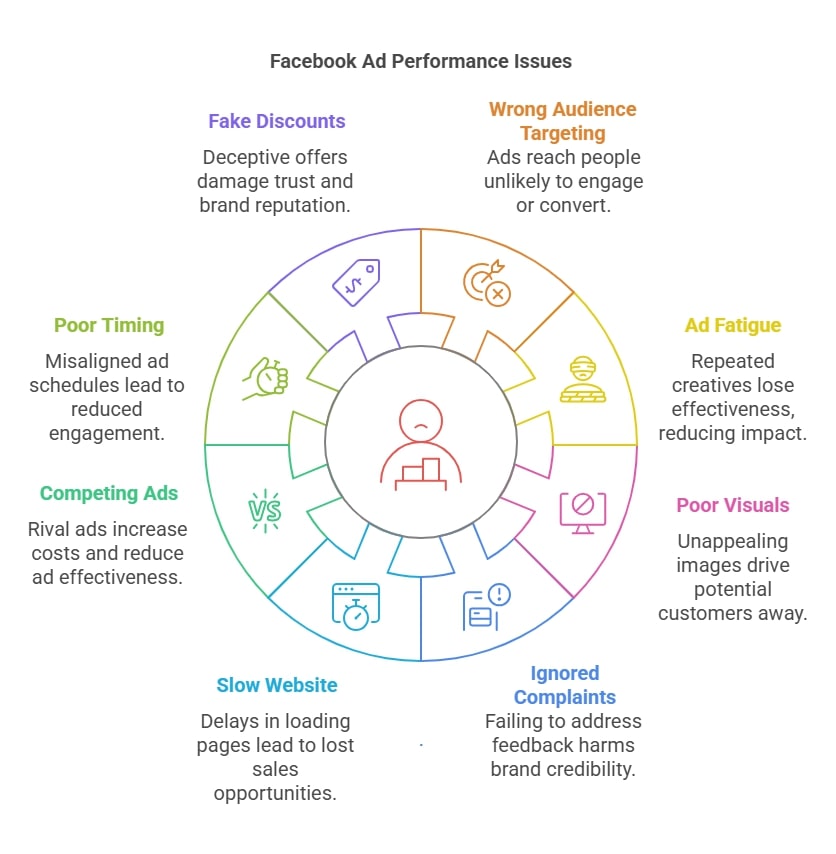
Meta Ads, formerly Facebook Ads, are very important for businesses aiming to reach a large audience. With 3.07 billion active users in 2025, Meta advertising offers great targeting options. Facebook ads optimization is the continuous process of optimizing your ad campaigns to better performance and it helps you improve engagement, increase conversions and lower costs. Businesses that get into meta campaign optimization see a 31% increase in impressions, showing how important it is.
Many businesses face challenges with rising ad costs, low engagement and poor Ad targeting. Our tips on how to optimize Facebook ads will help you optimize your ads, reduce Cost-per-click (CPC) and Click-through rate (CTR) plus conversions for better results.
What is Facebook Ads Optimization?
Facebook Ads Optimization is the process of fine-tuning your Facebook ad campaigns to achieve better results (like clicks, sales, or visibility) while spending less money. It involves adjusting your target audience, ad content, budget, and ad delivery timing based on performance data and so on.
It’s a continuous process that meta ads professionals perform to achieve the desired results from the current campaigns.
As a Meta advertising professional, I test different images, audiences, ad placements, and many more to optimize my Facebook ad campaign for best results, then I make sure my spending budget is spent on the top-performing options. Facebook Ads Manager can automate this part of the process to help you reach the right people at the right time.
Common Reasons Of Poor Facebook Ad Campaign Performance
If you’re running Facebook ads without full knowledge it can be tough and tricky. Campaigns often fail due to common mistakes. Here are some significant issues that can harm your ad campaign’s performance.

1. Ad Targeting for Wrong Audience
If ads reach the wrong people, they will not convert. For example, a luxury handbag brand runs ads for teenagers, but they do not have the budget to buy the product.
Choosing an audience and Audience segmentation is essential as per their genuine purchasing power along with other things like demography etc. Custom audiences on Facebook are created by uploading customer data, using website visitors, app users or by tracking their engagement with previous ads to target specific groups.
It is always the best option to hire a meta advertising agency to optimize your meta campaigns and bring out its robust performance.
2. Ad Fatigue – Overused Creatives Lose Impact
When the same ad runs too long, people start ignoring it. A shoe brand continuously displays the same sale banner for months, leading to reduced engagement. Refreshing Ad bidding strategy and creatives regularly keeps the audience interested.
3. Poor Visuals Drive Customers Away
Low-quality images or videos make products less appealing. A clothing brand uses blurry product images, making the outfits look unattractive. High-quality, well-lit images can improve trust and conversions.
4. Ignoring Customer Complaints Hurts Credibility
Unaddressed complaints reduce brand trust. A skincare brand gets multiple comments about allergic reactions but does not respond. Acknowledging and resolving customer concerns can maintain credibility.
5. Slow Website Kills Sales
Even the best ads fail if the landing page is slow. A gadget store’s checkout page takes too long to load, frustrating potential buyers. A fast-loading website improves conversion rates.
6. Competing Ads Increase Costs
Running multiple ads targeting the same group or for lookalike audiences, can waste money. A beauty brand unknowingly targets the same audience across different campaigns, causing ads to compete against each other. Proper audience segmentation prevents this.
7. Poor Timing Reduces Engagement
Ads shown at the wrong time miss the audience’s attention. A breakfast cereal brand runs ads at midnight when no one is thinking about breakfast. Timing ads based on audience activity improves engagement.
8. Fake Discounts Damage Trust
Customers lose faith when they notice manipulated prices. A fashion store increases prices before a sale, making discounts appear bigger. Shoppers quickly detect such tactics, leading to lower sales.
9. Lack of Social Proof Lowers Conversions
The absence of customer reviews or testimonials reduces confidence. A jewelry store does not display user ratings, making new buyers hesitate. Showcasing positive reviews on the ads that are running, increases trust and conversions.
10. Poor Mobile Experience Leads to Drop-offs
A bad mobile shopping experience drives users away. A furniture store has a difficult-to-navigate mobile site. This will be causing customers to abandon purchases. You need to ensure a fast and smooth mobile experience for targeted conversions.
How to Optimize Facebook Ads for Better Performance
Now, we are sharing a brief Facebook ads optimization checklist that will help you overcome the hurdles you face when optimizing your Facebook ads campaigns.
1. Perfect Your Campaign Balance
A well-structured campaign performs better. And for that, avoid too much segmentation, as it can limit data. However, too little segmentation can mix different audiences, reducing effectiveness. Ad group segmentation refers to dividing your target audience into smaller, more specific groups. It is based on shared characteristics or behaviors. This helps in creating compelling ads for each group to improve relevance and performance.
- Campaign Level is the top level where you set your campaign objective (e.g., traffic, conversions).
- Ad Set Level is the next one where you define your audience, budget, schedule and placement of ads. Multiple ad sets can exist within one campaign.
- Ad Level is the last level where an individual ad is within the ad set. This would be containing creative content, copy and the link to the destination.
An effective Facebook campaign optimization means clear ad sets, the right budgets, and proper targeting. For example, a fashion store should not mix ads for men’s shoes and women’s dresses in one campaign. Keep similar products together and test different segments. This helps understand which audience responds best. Check campaign reports often. If one group is not working, adjust budgets. A balanced approach improves results.
2. Take Data Driven Decisions
Data helps in making the right changes. Before changing anything, check the reports. Look at the cost per click (CPC), return on ad spend (ROAS), and engagement. For example, an online electronics store should check which products get clicks from certain locations but not sales. You will then need to target the location with Meta Ads where you get sales. Also if an ad has high engagement but no purchases, retarget those users. This tactic will increase the chances of growing your sales quickly.
Analytical data is the base to decide whether a certain advert is working. Accordingly, you will need to help continue, pause or change Meta ads to stay specific. Always test changes on a small scale before making major updates.
3. Make Sure Your Clicks Lead Visitors to Conversions
Clicks alone do not mean success. Visitors should take action, like adding to cart or purchasing. A skincare brand may get many clicks on a discount ad, but if people leave the website without buying, something is wrong. The landing page should match the ad.
If the ad promotes a “50% off sale,” the landing page should show the same offer clearly. A confusing website or too many steps in checkout can cause drop-offs. Track user behavior during Facebook campaign optimization to find out why and where people leave. Fix slow-loading pages, confusing layouts or extra steps in checkout.
4. Pinpoint Funnel Drop-Offs
A sales funnel has many steps. You need to find out where users drop off. Track data from impressions to reach, clicks, landing page views, add-to-carts (ATCs), checkouts, and purchases. For example, a home decor brand sees 1,000 clicks but only 100 ATCs. This means the product page is a problem and will impact the campaign budget optimization. Maybe the price is too high or the page lacks trust signals like reviews. If checkout drop-offs are high, test different payment options. Adjusting one weak stage can improve overall conversions.
5. Target the Right Audience with Precision
First, check you are using Facebook’s URL parameters to send users to the relevant landing pages based on the ad they clicked. Check who engages with the ads and website. A sportswear brand running ads for running shoes should see if runners are engaging. Metrics like time spent on the site and clicks on related products help determine this. If visitors leave quickly, they may not be the right audience. Adjust targeting based on engagement signals.
You can use lookalike audiences based on past buyers. Exclude people who have already purchased to avoid wasted spending. The buyer’s audience you can target on the remarketing campaigns. The right audience leads to better conversions from your Facebook ads campaign.
6. Test Your Website Flow
Before running ads, test the website flow. A beauty brand selling organic skincare must ensure the checkout works smoothly. Place a test order as a customer. Check if the add-to-cart button works, payment methods function correctly, and the confirmation page loads. If the process is slow or confusing, customers will leave. Even small issues during Facebook campaign optimization, like an unclear shipping policy can reduce sales. Service-based businesses should check lead forms. If forms are long or unclear, visitors may not complete them. Regular testing prevents the loss of potential customers.
Pro Tip: Only ask for relevant information in the lead form from users. Too many details in the lead form might send the wrong signal to users and risk losing conversions.
7. Ensure Spot-On Conversion Tracking
Conversion tracking must work correctly. If Click-through rate (CTR) tracking is wrong, ad decisions will be incorrect. For example, a pet supply store may see sales but no recorded conversions. This means the tracking pixel is broken. Use Meta Event Manager to test events. Click on test purchases and see if they register. Also, check for duplicate tracking, which can inflate results. If the pixel does not work, ad optimization fails. Debug tracking issues during Meta ads optimization before scaling any campaigns. Accurate tracking ensures real data and better ad decisions.
Pro tip: Make sure your phone number and email click tracking working smoothly. If they are not working fine, you might harm your conversions and lose a potential customer.
8. Create Trend-Driven Ad Content
Trendy content increases engagement. Use new content styles that people enjoy and might want to read. For example, short-form videos like Reels work better than static images for a fashion brand. A food brand can post recipe videos instead of just product photos. Test different formats like carousels, GIFs, or behind-the-scenes clips. Use viral trends but keep them relevant to the brand. If meme marketing is trending, use it for humorous engagement. Ads should feel fresh and not repetitive. Rotating creatives often prevents ad fatigue.
9. Spy on Competitors with Facebook Ads Library
Check what competitors are doing. Meta Ad Library shows active ads from any brand. A travel accessories brand can search for similar businesses and see their best-performing ads. Notice ad styles, messages, and offers they use. If multiple competitors use video ads, it may be a trend worth testing. Also, look at how often they change ads. Frequent updates mean they are testing actively. Learning from competitors on how to scale through Facebook campaign optimization saves time. Do not copy directly, but take inspiration and improve upon their strategies.
10. CRO (Conversion Rate Optimization) with Session Recording Tools
Session recording tools help track user behavior. Use tools like Hotjar or Microsoft Clarity. An online furniture store can install these tools and see where users struggle. If visitors hesitate before clicking “Buy,” it may indicate trust issues. Watching session replays helps understand pain points. If users scroll but do not add to cart, test different CTA buttons. If they abandon carts often, check if the checkout process is too complicated. These insights on Facebook advertising optimization help make better changes. Install these tools at the start of ad campaigns to track real-time behavior and do campaign budget optimization accordingly.
Get Most Out Of Your Facebook Ads Campaigns
A notable 77% of marketers perform Meta Ads optimization to increase their reach and grow their brand. Advertisers can lower their cost per purchase or CPC by 68% when they keep their overall spending in an ad’s learning phase under 20%.
This and more can be achieved simply by following the Facebook ads optimization checklist we have shared above. And also by incorporating the advanced tips we have shared. And if you further need any assistance towards Facebook campaign optimization and drive better ROI, then do write to us. We are here to take strong and quick action now and implement these strategies for stronger ad performance. Ready to start optimizing your ads? Contact us!

Contact Form Popup
Get in touch with us
This will close in 0 seconds
